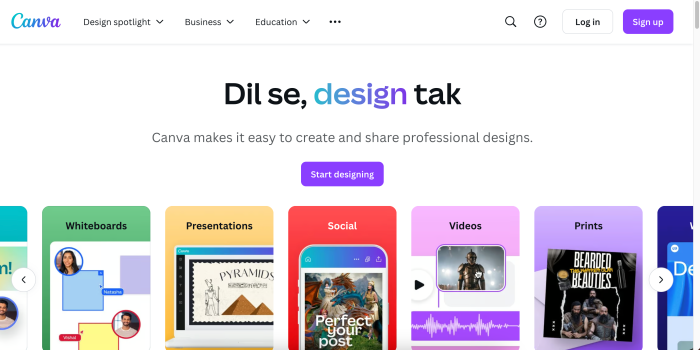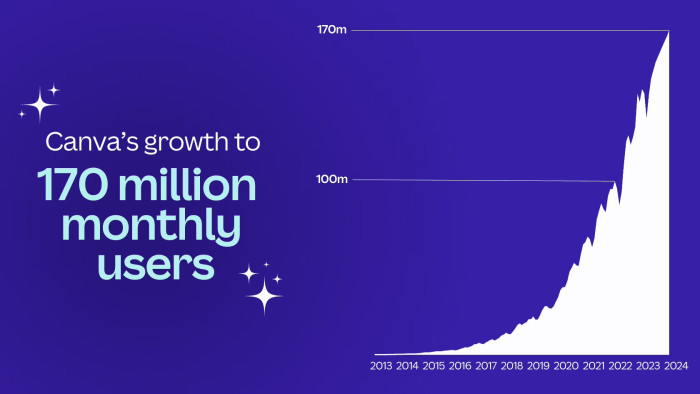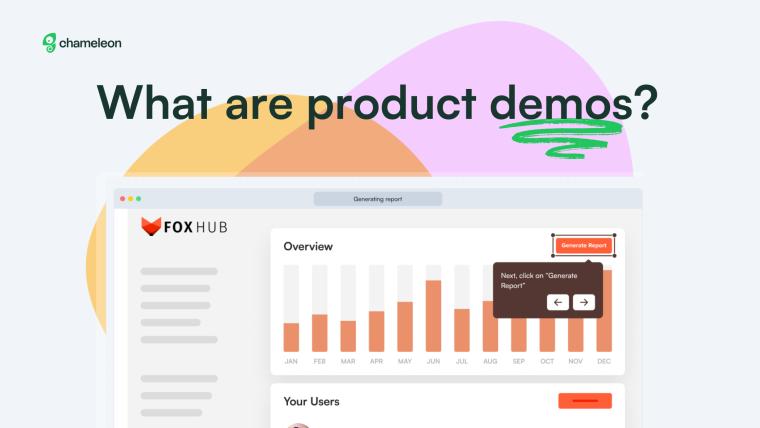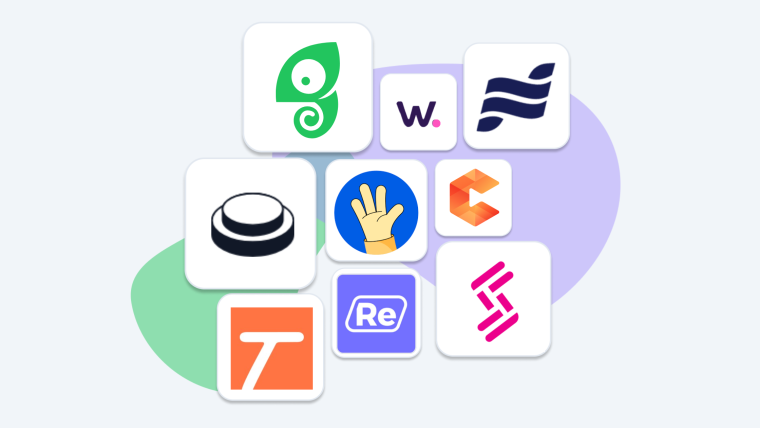Your product is so good, it practically sells itself. That’s the power of product-led marketing—a strategy where your product takes the lead in attracting, converting, and retaining customers. Instead of relying on flashy ads or aggressive sales tactics, you let your product do the heavy lifting by delivering real value right from the start.
But how exactly can you make this work for your SaaS? Product-led marketing requires a deep understanding of your users, precise timing, and a well-thought-out strategy to truly let your product shine.
In this article, we dive deeper into product-led growth marketing, how to apply it to your product and some of the best examples to inspire you!
Let’s build a user base that sticks around!
Product-led marketing puts your product at the center of your marketing strategy, bringing new sign-ups by letting users experience the product benefits firsthand
PLG marketing requires a collaborative effort from your product, sales, and marketing teams
Essential tactics include offering free trials or freemium models, creating educational content, and utilizing in-product resources to help users discover and engage with your product organically.
We also look at successful examples from companies like Slack, Canva, and Notion, showcasing how they’ve effectively implemented product-led marketing strategies
What is product-led marketing?
Product-led marketing is a strategy where you position your product center stage in your marketing efforts. Instead of bombarding potential customers with flashy ads you let them experience the product firsthand.
The idea is simple: if your product is truly valuable, users will recognize its worth on their own, making them more likely to become paying customers.
Even if they don't become paying customers, product-led marketing creates product-qualified leads (PLQs), making it easier for your sales team to target and convert people.
It’s a direct, user-centric, and ROI-driven marketing strategy for SaaS companies to deliver real value without empty promises that are notorious with ads.
Here’s how product-led marketing works:
Free sample, anyone? Start by giving potential customers a taste of your product. This could be through a free trial, a freemium model, or a limited access version. The goal is to let them experience the value firsthand.
Spot the fans. As users engage with your product, certain behaviors can indicate they’re becoming more invested. These users, often referred to as PQLs, might be actively using key features, regularly logging in, providing feedback, or exploring advanced functionalities. They’ve begun to see the value your product offers, signaling a deeper interest. While they aren’t guaranteed to convert into paying customers, their engagement level suggests they’re more likely to be open to a conversation about upgrading.
Gentle nudge, big impact. While free trial users interact with your productsmart prompts and suggestions guide them towards upgrades or additional features. It’s like saying, “Hey, you’re loving this—why not take it to the next level?”
Growth from within: After users convert, your product can continue to drive growth by offering contextual recommendations and personalized suggestions based on their usage patterns. By allowing users to explore additional features at their own pace and communicating offers through preferred channels, your product naturally encourages upselling and cross-selling without feeling pushy.
Measure and optimize. Product-led growth metrics like usage frequency, feature adoption, and upgrade rates are crucial. Based on these insights, you can tweak the product experience to better align with user needs and encourage conversions.
Product-led growth strategies vs. sales-led growth strategies
When it comes to growing your business, there are two main approaches: product-led growth and sales-led growth.
Here’s a quick look at the differences:
Product-Led Growth (PLG) | Sales-Led Growth (SLG) | |
Main driver | The product itself drives customer acquisition and growth | A dedicated sales team drives customer acquisition and growth |
Customer experience | Customers explore the product independently, often through free trials or freemium models | Customers are guided through the sales process by a sales rep |
Scalability | Highly scalable, as the product can attract and convert users with minimal human intervention | Requires hiring additional sales representatives and potentially increasing operational costs |
Conversion path | Users convert based on their hands-on experience with the product | Conversion happens through personalized sales pitches and follow-ups |
Cost structure | Lower upfront costs; relies more on product development and customer support | Higher costs due to sales salaries, commissions, and related expenses |
Why choose a product-led growth strategy: 5 product-led marketing benefits
Adopting PLG strategy puts your product at the heart of your marketing and sales efforts.
Cost-effective growth: PLG reduces the need for a large sales team and heavy marketing expenses. By letting the product drive customer acquisition, you cut down on traditional costs like paid advertising and cold outreach. This means more budget can be allocated to product development and user experience, further enhancing your product's appeal.
Faster user adoption: when users can directly interact with your product—through freemium models or free trials—they quickly experience its value. This immediate gratification leads to quicker adoption and conversion, speeding up the sales cycle. It’s like letting them test drive a car before buying; if they love the experience, they’re more likely to commit.
Scalability: as your product gains more users, it naturally becomes more valuable through network effects and word-of-mouth. This self-sustaining growth loop allows your business to scale rapidly without a proportional increase in sales or marketing efforts. Essentially, your product becomes its own best salesperson.
Improved customer satisfaction and retention: satisfied customers are more likely to stay loyal, reducing churn rates and turning them into advocates who promote your product to others.
Data-driven decision making: Data isn’t just numbers. PLG strategies are driven by user behavior data, helping you refine your product and marketing tactics on the fly. It’s tells you exactly what your customers want, so you can keep them coming back for more.
With all these benefits in mind, it’s clear that PLG can set your business on a path to sustained growth and customer satisfaction. But what are the core principles that make product-led marketing strategies so effective?
5 core principles of product-led marketing strategies
Achieving success with product-led marketing starts with a solid foundation of core principles that guide every decision and action. Here are the five core principles that drive your strategy.
1. Your product is also your primary marketing channel
In a PLG strategy, your product itself becomes the primary marketing channel, driving customer acquisition and engagement.
Products that users can share with others are especially effective in achieving organic growth. Features like referral programs or social sharing options within the product encourage users to spread the word.

Think about how Dropbox offered additional storage space when users invited friends. This approach turns your user base into a marketing engine, amplifying your reach without additional cost.
2. Prioritize user-centric, data-driven strategies
It’s all about the user. When you prioritize a user-centric approach, you focus on what really matters—how your product solves problems and improves the lives of your customers. But to truly understand your users, you need more than just intuition; you need data.
Data guides your marketing efforts to be more targeted and effective. It helps you identify which features users love, which ones they’re ignoring, and where they might be getting stuck. You can tweak your product and your messaging to better meet their needs.
A user-centric, data-driven approach also means continuously testing, learning, and iterating. What works today might not work tomorrow, so stay agile and ready to adapt. Keep an eye on key metrics like:
User activation rate: measures how many users reach a key milestone that indicates they've experienced the product's core value
Churn rate: tracks the percentage of users who stop using your product over a specific period
Customer lifetime value (CLTV): estimates the total revenue a customer will generate throughout their relationship with your product
Product usage frequency: monitors how often users engage with your product, indicating their level of interest and dependence
Net promoter score (NPS): gauges user satisfaction by measuring the likelihood of customers recommending your product to others
3. Align marketing campaigns to launches
Timing your marketing campaigns is everything. But this isn’t just about sending out a few emails or posting on social media. Align your marketing efforts with your launch to create a buzz surrounding your product, educate users, and drive early adoption. Creating pre-launch teasers, launch-day promotions, and post-launch educational content gives users all they need to successfully interact with your new product or feature.
After all, the real star of the show is your customer. Your product is simply the tool that helps them overcome their pain points, so your campaigns should focus on how this launch will make a real difference for them.
4. Focus heavily on increasing adoption
When users aren’t adopting your product, they’re missing out on the value you’ve worked hard to create. And if they don’t see the value, they’re likely to say goodbye.
To keep that from happening, your product-led marketing should go all out in helping users feel the love from day one. How? Start by crafting compelling stories (value narratives) that resonate with what your users need. Use social proof—think testimonials, case studies, or user reviews—to show potential users that others are already loving your product and actively using it to overcome their biggest pain points.
5. Provide seamless user onboarding
From the moment a user signs up, guide them through the key features of your product. Use interactive tutorials, tooltips, or a step-by-step walkthrough to help users quickly get acquainted with your product’s most important features.
-(1).gif)
Let’s dive into how you can apply product-led marketing to your SaaS and turn those engaged users into loyal customers.
How to apply product-led marketing to your SaaS
Here’s a four-step framework to design a product-led marketing strategy and let your product do the talking, walking, and everything in between.
1. Interact with your customers to identify their pain points
Most product marketers drop the ball by relying solely on quantitative data to drive their acquisition strategies. PLG marketing focuses almost exclusively on your customers.
You need to invest your efforts in interacting with users, understanding their needs, identifying their challenges, and using this research to shape your in-product customer experience.
Survey your prospective customers and host interviews with existing users to ask questions like these:
What’s pushing them away from their current way of doing things?
What are their biggest problems with [your domain]?
How have they tried to resolve these problems?
What do they expect from a product like yours?
How has your product changed their lives?
What does their ideal solution look like?
For this, you can use in-app product surveys to ask feature-specific questions within your product and get more granular information. All this information can help your product team enhance the user experience and allow your sales team to sell to potential customers in their own words.
🎬 Webinar Recording: 6 Ways to Collect and Apply User Feedback to Improve Your Product
2. Let your users solve their problems on the fly
Once you know your users’ problems, create educational resources to help them discover your product organically and try it.
Ideally, users would turn to search engines to find feasible solutions for their pain points. Tap into this opportunity with a robust and SEO-driven content strategy.
Turn your customers’ questions, challenges, and jobs to be done into product-led resources like blog posts, video tutorials, and eBooks covering the entire content funnel.
Jakub Rudnik, who leads content marketing at Scribe, shared a fast and effective playbook to do this in one of his LinkedIn posts, as captured below.

Jakub Rudnik's playbook with examples from Scribe
Another way to educate users about your product’s capabilities is through in-app marketing campaigns and self-serve support. These in-app guides and tips can help users on freemium plans or free trials navigate your tool and reach their “aha!” moments, convincing them to become paying customers.
Here are a few ideas for in-app messaging to educate customers.
Onboarding checklists
Welcome users with a seamless onboarding flow that acquaints them with the basic product features and use cases–it could look like this one created with Chameleon.

An example of an onboarding checklist built with Chameleon
Tooltips and guides
Deliver contextual support wherever possible to help users get the best out of the product functionality, especially the premium features, like this one by Evernote.

Source: Evernote
Self-guided tours
Design multi-step interactive product tours and feature walkthroughs to give new users a hang of your product from the start, like this one by Waldo.

Source: Waldo
Knowledge base
Empower users to troubleshoot their problems independently and quickly with an exhaustive knowledge base, like this example by Airmeet.

Source: Airmeet
Remember: Creating educational resources helps you target potential customers with empathy rather than pushy marketing tactics. It puts them on the wheel to discover your product’s value and become power users and keeps the power and choice in their hands.
Interactive demos
When you want to show users the power of your SaaS product, nothing beats letting them dive in and explore for themselves. Interactive demos are a fantastic way to give users that hands-on experience without making them commit to anything upfront. Instead of just hearing about what your product can do, users can see it in action, solving their problems as they interact with it.
👉 Explore an interactive demo and see how easy it is to build a product Tour with Chameleon, without any code.
3. Start identifying PQLs and double down on them
Product-led marketing tactics prioritize product-qualified leads (PQLs) over sales and marketing leads.
Every product-led company has its definition of a PQL based on its features. For example, a lead becomes a product-qualified lead for Slack when they cross the limit of 2,000 messages.
Essentially, a lead should experience the product value and be in line with your ideal customer profile to become a product-qualified lead. They shouldn’t need any further convincing from marketing or sales.
Start by establishing your criteria for a product-qualified lead to ramp up your organic growth through PLG marketing and reduce your customer acquisition cost (CAC).
Once you have these criteria, map the customer lifecycle funnel to find opportunities to optimize their user experience and nudge them to activation faster.
Since PQLs have already discovered your product’s core value proposition, they’re more likely to convert to paying customers quicker—helping you achieve your key business outcomes faster.
4. Bring marketing and product teams together
With your product taking center stage for all marketing campaigns, your PLG marketing success depends on your product marketing and product teams’ collaborative effort.
Product marketers are the voice of your customers. They have to constantly interact with your target buyers and think from their perspectives to help your team hit their sales goals.
They act as a bridge between your developers and end-users to take your customers' pulse and relay needs to the team. They're the facilitators of constructive communication, ensuring your product achieves what it's designed for, or what’s expected of it.
As a final step in your PLG growth strategy, create cross-functional workflows and product marketing team structures to ensure your marketing and product teams work as a cohesive unit and are able to do so easily.
Once you bring teams on the same page, follow these four product-led marketing tactics to boost user success and maximize customer retention of your new users.
5 Company examples of product-led marketing
To help you grasp the power of PLG, we’ve gathered five companies that are doing product-led marketing the right way. These examples will show you how they’ve successfully put their product at the forefront, driving growth and engagement in innovative ways.
1. Slack
Slack is a textbook example of product-led marketing done right. From its early days, Slack focused on getting its product into the hands of users quickly and easily. The company offers a generous free plan for teams of up to 10,000 members. This allows teams to experience the core features without any upfront cost. Slack’s approach removes the friction typically associated with traditional sales processes, letting the product speak for itself.

One of Slack’s key strategies was making the platform incredibly easy for teams to get started. Users can sign up and create a workspace in minutes, start inviting team members, and immediately see the benefits of organized, real-time communication. This instant value helped Slack spread like wildfire within organizations, as teams quickly realized how it could transform their workflows.
Moreover, Slack’s product-led growth was amplified by its focus on virality. As more teams within an organization adopted Slack, it naturally became the central hub for communication, leading to organic growth across departments and even entire companies.

Slack turned its product into its best marketing tool, driving widespread adoption and eventually leading to its acquisition by Salesforce in December 2020 for $27.7 billion.
2. Canva

Canva aims to simplify design, so users can create professional-quality graphics without the need for specialized skills. The platform’s intuitive drag-and-drop interface and vast library of templates made it easy for users to start designing immediately.
One of Canva’s most effective strategies is offering a freemium model that lets users access a significant portion of its features for free. This approach allows users to experiment with the product, experience its value, and become comfortable with its tools before ever needing to pay.
Canva has also truly embraced global diversity, as shown in their regional adaptations, such as offering Hindi language support for Indian users. Their tagline "Dil se, design tak" perfectly captures this localized approach. This regional customization is a key part of their product-led marketing strategy. By making the product more relevant and easier to use for specific markets, Canva improves user experience, driving higher engagement and adoption.
As users created and shared their designs, often with Canva’s watermark, they inadvertently became ambassadors for the brand, driving more people to try it out.

The instant gratification users get from Canva—being able to produce visually appealing content with minimal effort—has been key to its success. As users gain confidence and want more advanced features, many choose to upgrade to Canva Pro, which offers additional tools and capabilities.

This transition from free to paid plans has helped Canva grow its user base to 170 million users monthly worldwide.
3. Notion

Founded in 2013 by Ivan Zhao, Notion has mastered the art of product-led marketing by creating a tool that users can mold into anything they need it to be—whether it’s a note-taking app, project management tool, or personal wiki. This flexibility has helped Notion attract a diverse range of users, from solo freelancers to large companies.

A standout feature of Notion’s strategy is its community-driven growth. Users love to share their custom templates, workflows, and use cases across social media and blogs. This user-generated content acts as organic marketing, drawing in new users who see how easily they can tailor Notion to their needs.

Notion’s free plan is also a big part of its success. It provides enough functionality for users to get a real sense of the product’s potential, which naturally encourages them to explore more advanced features that come with the paid plans.
When the pandemic hit, remote workers needed a tool that could do it all—organize notes, manage projects, and keep everything in one place. Notion was that tool. Its flexibility made it a favorite for both individuals and teams, and today, it’s used by millions, including big names like Slack, Netflix, and Spotify.
4. Airtable

Airtable is a perfect example of how to take something familiar, like a spreadsheet, and turn it into something so much more. From the start, Airtable positioned itself as a tool that combines the simplicity of spreadsheets with the power of databases. This unique blend attracted a wide range of users, from small businesses to large enterprises, looking for a better way to manage their data.

What really set Airtable apart was how easy it made it for users to start building. With a clean, intuitive interface, users could create their own custom applications without needing to write a single line of code.
This “build-it-yourself” approach resonated with teams who wanted flexible tools that could adapt to their specific needs. And as users started building, they quickly saw the potential of Airtable to simplify their work, making it a tool they couldn’t work without.

5. Chameleon

Chameleon is a product adoption platform designed to improve user onboarding and create effective in-app feedback loops. It allows users to create interactive product tours, feature walkthroughs, and in-app messaging to help users navigate and understand their product.
Chameleon regularly hosts tactical workshops and webinars on product-led growth topics. For example, they recently held a workshop on "How to drive PLG in 2024," featuring insights from growth experts at Chameleon and Customer.io. These events provide value to their audience while showcasing their expertise and product features.

Chameleon also offers a free trial and access to their sandbox environment, allowing potential customers to experience the product's value without commitment. This low-barrier entry point is a key aspect of their product-led marketing strategy.

Nudge users towards conversion with seamless in-app experiences
With precise targeting and immaculate timing, Chameleon can turn user engagement into revenue.
Let your product do the (marketing) talking
Product-led marketing is a no-nonsense approach that puts your product at the center of every campaign, making the user experience feel natural and genuinely helpful.
But here’s the thing: product-led marketing isn’t just the job of the marketing team. It’s a company-wide effort. Your customer success team focuses on showing users how to get more out of the product, while your sales team helps trial users see the value in upgrading. Meanwhile, your engineering team is constantly improving the product to keep users engaged. Every department has a role in making the product shine.
So when you’re creating your own product marketing strategy, focus on solving real problems for your users. Your product should quietly guide them to the solution, making it clear that it’s the right choice without being pushy.
Let your users feel like they’re in control!
Help prospects choose your product faster
Create an actionable game plan and get started on your product-led marketing journey with Chameleon.





